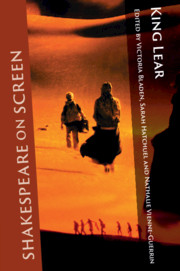Book contents
- Shakespeare on Screen: King Lear
- Series page
- Shakespeare on Screen: King Lear
- Copyright page
- Dedication
- Contents
- Illustrations
- Notes on Contributors
- Series Editors’ Preface
- Acknowledgements
- Chapter 1 Introduction: Dis-locating King Lear on Screen
- Part I Surviving Lear: Revisiting the Canon
- Part II Lear en Abyme: Metatheatre and the Screen
- Chapter 4 Filming Metatheatre: the ‘Dover Cliff’ Scene on Screen
- Chapter 5 New Ways of Looking at Lear: Changing Relationships between Theatre, Screen and Audience in Live Broadcasts of King Lear (2011–2016)
- Chapter 6 Re-shaping Old Course in a Country New: Producing Nation, Culture and King Lear in Slings and Arrows
- Part III The Genres of Lear
- Part IV Lear on the Loose: Migrations and Appropriations of Lear
- Index
- References
Chapter 4 - Filming Metatheatre: the ‘Dover Cliff’ Scene on Screen
from Part II - Lear en Abyme: Metatheatre and the Screen
Published online by Cambridge University Press: 10 September 2019
- Shakespeare on Screen: King Lear
- Series page
- Shakespeare on Screen: King Lear
- Copyright page
- Dedication
- Contents
- Illustrations
- Notes on Contributors
- Series Editors’ Preface
- Acknowledgements
- Chapter 1 Introduction: Dis-locating King Lear on Screen
- Part I Surviving Lear: Revisiting the Canon
- Part II Lear en Abyme: Metatheatre and the Screen
- Chapter 4 Filming Metatheatre: the ‘Dover Cliff’ Scene on Screen
- Chapter 5 New Ways of Looking at Lear: Changing Relationships between Theatre, Screen and Audience in Live Broadcasts of King Lear (2011–2016)
- Chapter 6 Re-shaping Old Course in a Country New: Producing Nation, Culture and King Lear in Slings and Arrows
- Part III The Genres of Lear
- Part IV Lear on the Loose: Migrations and Appropriations of Lear
- Index
- References
Summary
In 4.6, Edgar, who pretends to be Poor Tom, guides his blind father Gloucester towards Dover. Gloucester has asked to be led to the top of a cliff so that he can end his days. But the cliff is only an illusion created verbally by Edgar who wants to protect his father’s life. This scene uses the power of the Elizabethan stage to become a moment of pure theatre, calling for a bare stage to retain all its ambiguities. The aim of this contribution is to show how cinema and television can sometimes maintain, and even foster, the scene’s paradoxes of a non-space. The chapter interrogates the possibilities offered by the screen to reflect the complex dramatic and metadramatic tensions in several film productions of King Lear that use Shakespeare’s playtext. These screen productions, emerging from different media and production contexts, all present different strategies to represent the ‘cliff’ scene. From Richard Eyre’s 1998 film, to films made for television and video release, to feature films (Peter Brook’s in 1971), they all attempt, through textual cuts, framing and/or editing, to circumvent the problem posed by a scene that seems to encapsulate the very essence of the bare Elizabethan stage.
- Type
- Chapter
- Information
- Shakespeare on Screen: King Lear , pp. 65 - 77Publisher: Cambridge University PressPrint publication year: 2019
References
Works Cited
- 2
- Cited by

